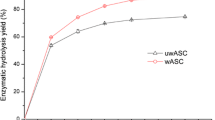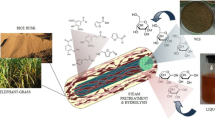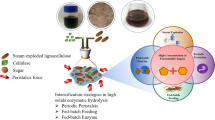Abstract
The weak acids, furan derivatives, and phenolic compounds formed during lignocellulose pretreatment are potential inhibitors of subsequent enzymatic and microbial processes. In this work, the effects of the steam explosion process on the formation of weak acids, furan derivatives, and phenolic compounds were explored. The correlations of different steam explosion conditions and formation kinetics of degradation products showed that the formation of weak acids and furan derivatives was in the first-order reactions, which are expressed as \( A\times {e^{{{{{-{E_a}}} \left/ {RT } \right.}}}}\cdot t \). The formation of weak acids and furan derivatives increases with pretreatment temperature and time. On the other hand, the formation of phenolic compounds showed typical characteristics of continuous reaction, expressed as \( {{{{A_1}\times {e^{{{{{-{E_{a1 }}}} \left/ {RT } \right.}}}}}} \left/ {{{A_2}\times {e^{{{{{-{E_{a2 }}}} \left/ {RT } \right.}}}}\cdot t}} \right.} \). The formation was affected by the active energies in two stages, temperature and time, and thus existed at extreme value. This work revealed the formation rules of weak acids, furan derivatives, and phenolic compounds in a steam explosion process and provided theoretical guidelines for improving the process and limiting the production of certain inhibitors.
Similar content being viewed by others
Explore related subjects
Discover the latest articles, news and stories from top researchers in related subjects.Avoid common mistakes on your manuscript.
Introduction
Lignocellulose, which is a complex of cellulose, hemicelluloses, and lignin, only renders approximately 20 % of its theoretical glucose yield upon subjection to enzymatic hydrolysis due to its recalcitrance [1, 2]. Therefore, lignocellulose needs to be pretreated to enable the cellulose to be more accessible to cellulolytic enzymes.
To date, various pretreatment methods have been developed including uncatalyzed steam explosion [3–5], liquid hot water [6], dilute acid [7], alkali [8], and so on. Steam explosion has been considered one of the most economical and efficient methods for disrupting different lignocellulosic plant materials into major plant components, such as cellulose, lignin, and hemicellulose [9–12]. Besides, recent review articles have shown that steam explosion offers several attractive features when compared to other fractionation technologies: lower environmental impact, lower capital investment, more potential for energy efficiency, fewer hazardous process chemicals and conditions, possibility of using a large chip size [13]. However, the hydrolysate contains, in addition to fermentable sugars, a broad range of compounds, such as weak acids, furan derivatives, and phenolic compounds [14], some of which present inhibitory effects on the cellulase components and/or are toxic to the microorganisms used in the fermentation [15–17]. The property, composition, and final concentration of inhibitors vary with the pretreatment conditions such as temperature, time, pressure, pH, and redox conditions [18], raw material species (hardwood, softwood, and herbaceous), and the type and content of catalyst [19–22].
Due to their inhibitory effects on productivity and end-product formation, the inhibitors can be a limiting factor in the feasibility of biotechnological conversions of lignocellulose [18]. Various researchers have demonstrated the capability to identify and/or quantify sugars and lignin degradation products resulting from chemical pretreatment of biomass. Fenske et al. [23] compared aromatic monomers in lignocellulosic biomass dilute acid prehydrolysates. Luo et al. [20] identified potential fermentation inhibitors in conversion of hybrid poplar hydrolyzate to ethanol. Palmqvist et al. [14] discussed the generation of inhibitors during degradation of lignocellulosic materials by dilute acid pretreatment and reviewed the inhibiting mechanisms of individual compounds on fermentation yield and productivity. Klinke et al. [18] systematically summarized the different inhibitors formed by pretreatment of lignocellulosic materials and their inhibition of ethanol production in yeast and bacteria. In Du et al. [24] research, the effects of varying pretreatment chemistry–feedstock combinations on degradation product formation and accumulation in biomass hydrolysates were analyzed. But the formation rules of potential inhibitors in steam explosion process were not reported in one consolidated study.
This work determined the types and concentrations of potential fermentation inhibitors of hydrolysates under different steam explosion conditions. The monitored compounds were hydroxymethylfurfural (HMF), furfural, 4-hydroxybenzaldehyde, vanillin, syringic, p-coumaric, p-hydroxybenzoic, ferulic, acetic, and formic acids. This range of compounds was selected based on the previous identification of these analytes as potential inhibitors resulting from biomass pretreatment [14, 18]. The formation kinetics of these inhibitors was studied, and the inhibitor conversion equations, inhibitor conversion relationships, and temperature and holding time in the steam explosion process were deduced. The understanding of these processes may be helpful in predicting inhibitors. This work also provides theoretical references for limiting the production of certain inhibitors by artificially controlling the temperature and holding time in the steam explosion process. Moreover, the formation of inhibitors in common pretreatments (such as dilute acid and liquid hot water, among others) was compared with that in steam explosion. This comparison illustrates the similarities and differences between the inhibitor formations of different pretreatments.
Materials and Methods
Materials
Corn straw (collected from Hebei Province, China) was harvested at maturity in September 2011 and was air-dried at room temperature. All chemicals used in this study were of analytical grade and purchased from Beijing Chemical Reagent Corp., China.
Corn Straw Pretreatment by Steam Explosion Technology
One hundred grams of corn straw was cut into 1–2 cm and was steam-exploded at 283, 294, 310, 328, 351, 378, 410, and 471 K for 2, 5, and 8 min separately at 1.5 MPa using mixture gas of saturated steam and N2 in a 4.5-L batch reactor (Weihai Automatic Control Reactor Ltd., China).
Yields of Inhibitors in Steam-Exploded Material Hydrolysates
Samples of 10 g steam-exploded materials (dry basis) were soaked in 200 mL water at 50 °C for 2 h and then centrifuged for 20 min at 8,000 r/min at room temperature in a Desk Centrifuge. The concentrations of furfural, HMF, syringic acid, 4-hydroxybenzaldehyde, vanillin, p-coumaric acid, p-hydroxybenzoic acid, and ferulic acid in the supernatants were determined by high-performance liquid chromatography (HPLC; Agilent 1200, American) using a method similar to that reported by Xiao et al. [25], equipped with a UV detector (G1314B) at λ280 and Eclipse XDB-C18 column at 30 °C with methanol water acetic acid (40:59.4:0.6, v/v/v) as the mobile phase at 0.6 mL/min. The concentrations of acetic acid and formic acid in the supernatants were determined by HPLC using a method similar to that reported by Laopaiboon et al. [26], equipped with a RI detector (G1362A) and Aminex HPX-87H column at 65 °C with 5 mM H2SO4 as the mobile phase at 0.5 mL/min. The yield of each compound was expressed as the mass ratio of that to original dry matter.
Results and Discussion
Identification of Potential Fermentation Inhibitors in Steam Explosion Hydrolysates
The last list of Table 1 shows the quantitative determination of the identified degradation compounds in the hydrolysates from the steam-exploded corn straw at 471 K for 8 min. The acetic and formic acids, HMF, and furfural from the hemicellulose degradation of corn straw were the main compounds present in the hydrolysate, which accounted for 82–96 % of the total inhibitors. p-Coumaric acid, vanillin, 4-hydroxybenzaldehyde, and syringic acid constituted a large fraction of the lignin-derived compounds in the hydrolysate, which accounted for 3–14 % of the total inhibitors. p-Hydroxybenzoic and ferulic acids were both in small quantities in the hydrolysate, the sum of which accounted for less than 3 % of the total inhibitors. And vanillic and 4-hydroxybenzoic acids were not detected in the hydrolysate of steam explosion pretreatment.
In general, it was observed that the types and concentrations of degradation products produced during pretreatment were more dependent upon the feedstock utilized than on the type of pretreatment chemistry employed. However, formation and accumulation of select compounds was dependent upon both feedstock and pretreatment chemistry [24]. From Table 1, the types of inhibitors observed in corn straw hydrolysates during different pretreatment technologies were almost the same. The yield of inhibitor differed in various pretreatments. The yield of the weak acids was highest in the NH3 pretreatment, whereas the yield of furan derivatives was highest in the dilute acid pretreatment. A few differences exist between the phenolic compound yield in different pretreatments. Vanillic and 4-hydroxybenzoic acids were not detected in the steam explosion pretreatment, whereas p-coumaric acid was detected only in the steam explosion pretreatment and not in the other pretreatments.
Yields of Inhibitors at Different Steam Explosion Conditions
Figures 1, 2, and 3 showed the yield of furan derivatives, weak acids, and phenolic compounds versus temperature and time during the steam explosion pretreatment. Figures 1 and 2 showed an increase in the yield of furan derivatives and weak acids with increasing pretreatment temperature and time. The same trend is observed with syringic acid (Fig. 3). However, the 4-hydroxybenzaldehyde, vanillin, and p-coumaric acids showed typical characteristics of continuous reaction (\( A\xrightarrow[T]{{{k_1}}}B\xrightarrow[T]{{{k_2}}}C \), where A denotes original corn straw, B represents the objective inhibitor, C denotes secondary degradation products, and k indicates equilibrium constant). Their yield did not have a linear relationship with the pretreatment temperature T and time t. The yield of the objective inhibitors in these reactions was affected by k 1/k 2 and time t. From the Arrhenius equation \( k=A\times {e^{{\frac{{-{E_a}}}{RT }}}} \), k was affected by E a and T. Thus, the yield of the objective inhibitors was \( {{{{A_1}\times {e^{{\frac{{-{E_{a1 }}}}{RT }}}}}} \left/ {{{A_2}\times {e^{{\frac{{-{E_{a2 }}}}{RT }}}}\cdot t}} \right.} \), in which the extremum exists at a given T or t.
Sun and Chen [27] found that some lignin and carbohydrates formed the lignin recondensation and/or LCC during the drying process of fiber. Under severe enough pretreatment conditions, the cleaved linkages of hemicellulose and lignin form other linkages, i.e., lignin recondensation [28, 29]. Lignin recondensation or LCC formed may be the reasons for the yield of 4-hydroxybenzaldehyde, vanillin, and p-coumaric acids not having a linear relationship with the pretreatment temperature T and time t but first increasing then dropping.
As shown in Fig. 3, when the pretreatment time t was less than 5 min, the yield of 4-hydroxybenzaldehyde increased with temperature. However, when t was 8 min, the yield initially increased, then decreased, and finally reached the maximum at 328 K. At the same pretreatment time t, the yield of vanillin increased with temperatures from 283 to 351 K but remained unchanged at temperatures higher than 351 K. Moreover, when pretreatment time t was longer than 2 min and temperature was higher than 351 K, the yield of vanillin showed a downward trend. As pretreatment time t increased, the yield of p-coumaric acid increased at temperatures from 283 to 328 K. However, the yield of p-coumaric acid decreased at temperatures higher than 328 K. The yield of p-coumaric acid at 5 min was larger than that at 8 min. This difference may be due to the larger k 1/k 2 of p-coumaric acid at 8 min than that at 5 min.
Dynamic Parameters and Yield Equations of Inhibitors in Steam Explosion Process
Table 2 shows the equilibrium constants of the objective inhibitors at each temperature level. From Figs. 1 to 3, the yield of HMF, furfural, syringic, acetic, and formic acids was positively correlated with pretreatment time and temperature. Thus, an equilibrium constant exists in each compound for each temperature level. The formations of 4-hydroxybenzaldehyde, vanillin, and p-coumaric acids were continuous reactions, and their yield was affected by several factors; thus, their equilibrium constants were difficult to express and not calculated in this work.
According to the equation, \( \mathrm{In}\,\kappa =\mathrm{In}\,A-\frac{{{E_a}}}{RT } \), the k versus 1/T plot would yield an activation energy E a and pre-exponential factor A. Tables 3 and 4 show the dynamic parameters and Arrhenius equations of the five model inhibitors, respectively.
Table 5 shows the yield equations of HMF, furfural, syringic, acetic, and formic acids. The yields of the inhibitors could be associated directly with the time and temperature of the steam explosion pretreatment. Thus, the yields of inhibitors could be predicted and calculated before the actual determination, even before the steam explosion experiment.
Conclusions
The purpose of this work was to understand better the formation rules of potential fermentation inhibitors and the quantitative relation of the yields of inhibitor and pretreatment conditions. This information provides theoretical references for limiting the production of certain inhibitors by controlling the pretreatment temperature and time.
The analysis of the formation kinetics of ten fermentation inhibitors in the steam-exploded material hydrolysates showed that the formation rules of weak acids, furan derivatives, and phenolic compounds were different. The formation rules of weak acids and furan derivatives were first-order reactions, whereas those of phenolic compounds were continuous reactions. A more thorough mechanistic understanding of the formation of phenolic compounds formation in steam-exploded material hydrolysates is therefore needed.
References
Kim, T. H., Lee, Y. Y., Sunwoo, C., & Kim, J. S. (2006). Applied Biochemistry and Biotechnology, 133, 41–57.
Bak, J. S., Ko, J. K., Han, Y. H., Lee, B. C., Choi, I., & Kim, K. H. (2009). Bioresource Technology, 100, 1285–1290.
Zhang, Y. Z., & Chen, H. Z. (2012). Chemical Engineering Science, 75, 177–182.
Chen, H. Z., & Liu, L. Y. (2007). Bioresource Technology, 98, 666–676.
Sun, F. B., & Chen, H. Z. (2008). Journal of Chemical Technology and Biotechnology, 83, 707–714.
Cara, C., Moya, M., Ballesteros, I., Negro, M. J., González, A., & Ruiz, E. (2007). Process Biochemistry, 42, 1003–1009.
Vancova, T., & McIntosha, S. (2011). Journal of Chemical Technology and Biotechnology, 86, 818–825.
Hu, Z. H., & Wen, Z. Y. (2008). Biochemical Engineering Journal, 38, 369–378.
Peng, X. W., & Chen, H. Z. (2012). Process Biochemistry, 47, 209–215.
Talebnia, F., Karakashev, D., & Angelidaki, I. (2010). Bioresource Technology, 101, 4744–4753.
Kumar, P., Barrett, D. M., Delwiche, M. J., & Stroeve, P. (2009). Industrial and Engineering Chemistry Research, 48, 3713–3729.
Saddler, J., Ramos, L., & Breuil, C. (1993). In J. Saddler (Ed.), Bioconversion of Forest and Agricultural Plant Residues (pp. 73–73). UK: C.B.A. International.
Alvira, P., Tomás-Pejó, E., Ballesteros, M., & Negro, M. J. (2010). Bioresource Technology, 101, 4851–4861.
Palmqvist, E., & Hahn-Hägerdal, B. (2000). Bioresource Technology, 74, 25–33.
Emmel, A., Mathias, A. L., Wypych, F., & Ramos, L. P. (2003). Bioresource Technology, 86, 105–115.
Cantarella, M., Cantarella, L., Gallifuoco, A., Spera, A., & Alfani, F. (2004). Process Biochemistry, 39, 1533–1542.
García-Aparicio, M. A. P., Ballesteros, I., González, A., Oliva, J. M., Ballesteros, M., & Negro, M. A. J. (2006). Applied Biochemistry and Biotechnology, 129–132, 278–288.
Klinke, H. B., Thomsen, A. B., & Ahring, B. K. (2004). Applied Microbiology and Biotechnology, 66, 10–26.
Palmqvist, E., Hahn-Hägerdal, B., Galbe, M., & Zacchi, G. (1996). Enzyme and Microbial Technology, 19, 470–476.
Luo, C., Brink, D. L., & Blanch, H. W. (2002). Biomass and Bioenergy, 22, 125–138.
Martinez, A., Rodriguez, M. E., Wells, M. L., York, S. W., Preston, J. F., & Ingram, L. O. (2001). Biotechnology Progress, 17, 287–293.
Oliva, J. M., Sáez, F., Ballesteros, I., Gonzalez, A., Negro, M. J., Manzanares, P., & Ballesteros, M. (2003). Applied Biochemistry and Biotechnology, 105, 141–153.
Fenske, J. J., Griffin, D. A., & Penner, M. H. (1998). Journal of Industrial Microbiology and Biotechnology, 20, 364–368.
Du, B., Sharma, L. N., Becker, C., Chen, S. F., Mowery, R. A., van Walsum, G. P., & Chambliss, C. K. (2010). Biotechnology and Bioengineering, 107, 430–440.
Xiao, L., Xu, F., & Sun, R. C. (2011). Fibers and Polymers, 12, 316–323.
Laopaiboon, P., Thani, A., Leelavatcharamas, V., & Laopaiboon, L. (2010). Bioresource Technology, 101, 1036–1041.
Sun, F., & Chen, H. Z. (2008). Bioresource Technology, 99, 5474–5479.
Li, J., & Gellerstedt, G. (2008). Industrial Crops and Products, 27, 175–181.
Kobayashi, T., Kohn, B., Holmes, L., Faulkner, R., Davis, M., & Maciel, G. E. (2011). Energy & Fuels, 25, 1790–1797.
Acknowledgments
This work was financially supported by the National Basic Research Program of China (973 Project, no. 2011CB707401), the National High Technology Research and Development Program of China (863 Program, SS2012AA022502), and the National Key Project of Scientific and Technical Supporting Program of China (no. 2011BAD22B02).
Author information
Authors and Affiliations
Corresponding author
Rights and permissions
About this article
Cite this article
Zhang, Y., Wang, L. & Chen, H. Formation Kinetics of Potential Fermentation Inhibitors in a Steam Explosion Process of Corn Straw. Appl Biochem Biotechnol 169, 359–367 (2013). https://doi.org/10.1007/s12010-012-9961-8
Received:
Accepted:
Published:
Issue Date:
DOI: https://doi.org/10.1007/s12010-012-9961-8







